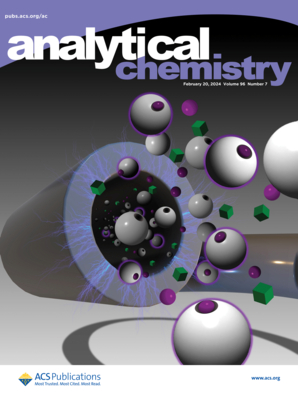Fabricating Cu Single Atom Sites on Ce-BTC for Sensitive and Durable Detection of Multipollutions in Water
IF 6.7
1区 化学
Q1 CHEMISTRY, ANALYTICAL
引用次数: 0
Abstract
Easy and mass preparation of highly efficient single atomic electrocatalysts (SAECs) for wide applications in constructing sensitive electrochemical sensing remains a great challenge. In this work, a heterogeneous SAEC was synthesized by dispersing the copper phthalocyanine (CuPc) molecular on porous Ce-BTC for sensitive, simultaneous detection of NO2– and Bisphenol A (BPA) in water. Herein, CuPc has a typical Cu-nitrogen–carbon (Cu–N4) conjugated structure and highly efficient single-atom catalytic sites with excellent catalytical efficiency and conductivity, while Ce-BTC exhibited adsorption and activation of NO2– and BPA, as well as provided matrix to better disperse CuPc to obtain Cu–N4/Ce-BTC heterogeneous catalysts. Thus, the synergistic effect of CuPc and Ce-BTC enables Cu–N4/Ce-BTC to have a highly efficient catalytic activity and stability. Impressively, the coordinated carbon and nitrogen atoms surrounding the Cu help in activating pollution molecules, which can further enhance the sensitivity. As a result, the Cu–N4/Ce-BTC sensor for detecting NO2– and BPA exhibited good stability, reproducibility, selectivity, and a wide linear range of 20–1000 μM and 10–1000 μM with a low detection limit of 0.5 and 0.15 μM, respectively. This research presents a simple and mass product synthesizing SAECs approach, which will promote the development of SAEC applications in electrochemical sensors.

求助全文
约1分钟内获得全文
求助全文
来源期刊

Analytical Chemistry
化学-分析化学
CiteScore
12.10
自引率
12.20%
发文量
1949
审稿时长
1.4 months
期刊介绍:
Analytical Chemistry, a peer-reviewed research journal, focuses on disseminating new and original knowledge across all branches of analytical chemistry. Fundamental articles may explore general principles of chemical measurement science and need not directly address existing or potential analytical methodology. They can be entirely theoretical or report experimental results. Contributions may cover various phases of analytical operations, including sampling, bioanalysis, electrochemistry, mass spectrometry, microscale and nanoscale systems, environmental analysis, separations, spectroscopy, chemical reactions and selectivity, instrumentation, imaging, surface analysis, and data processing. Papers discussing known analytical methods should present a significant, original application of the method, a notable improvement, or results on an important analyte.
 求助内容:
求助内容: 应助结果提醒方式:
应助结果提醒方式:


